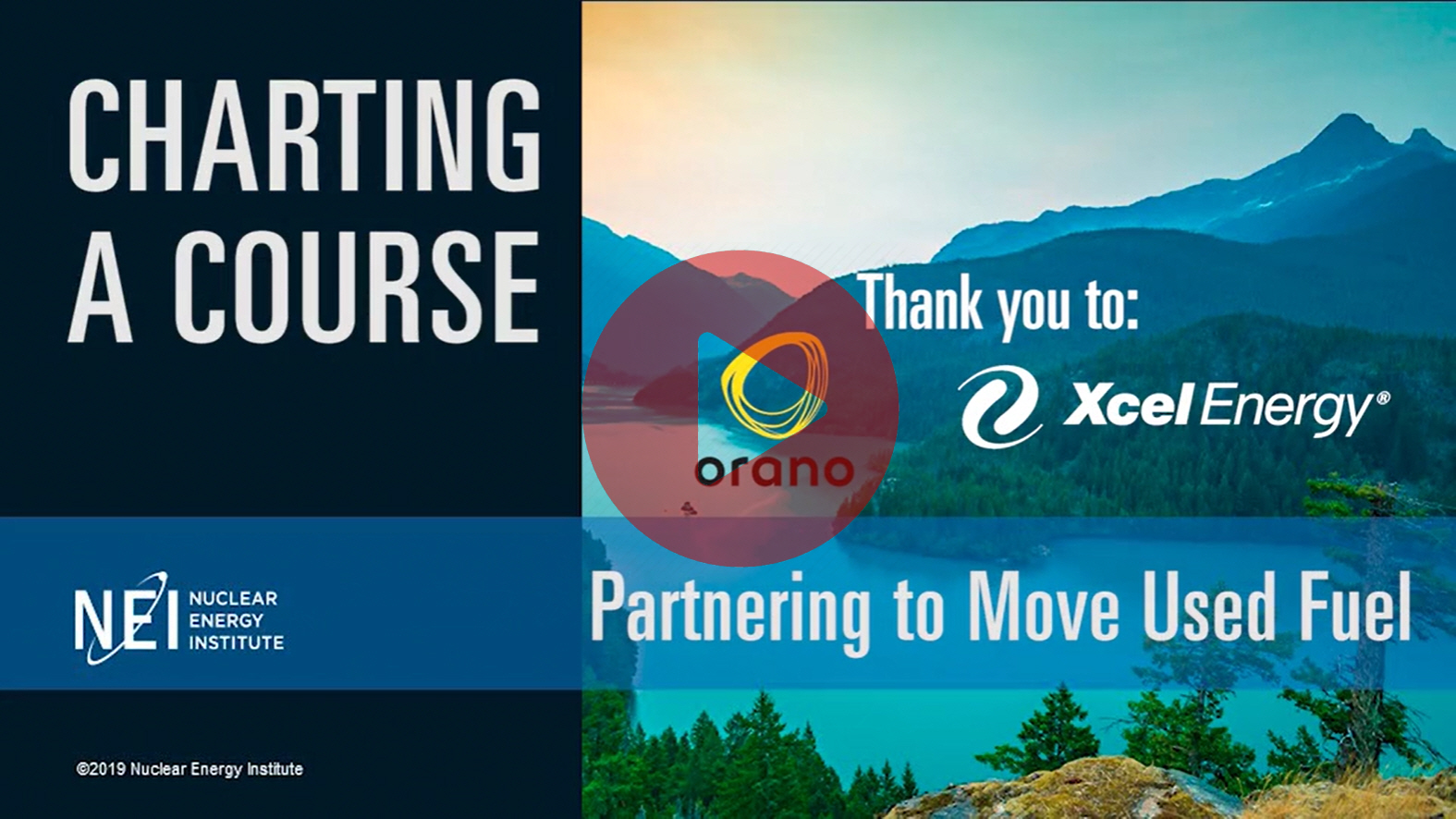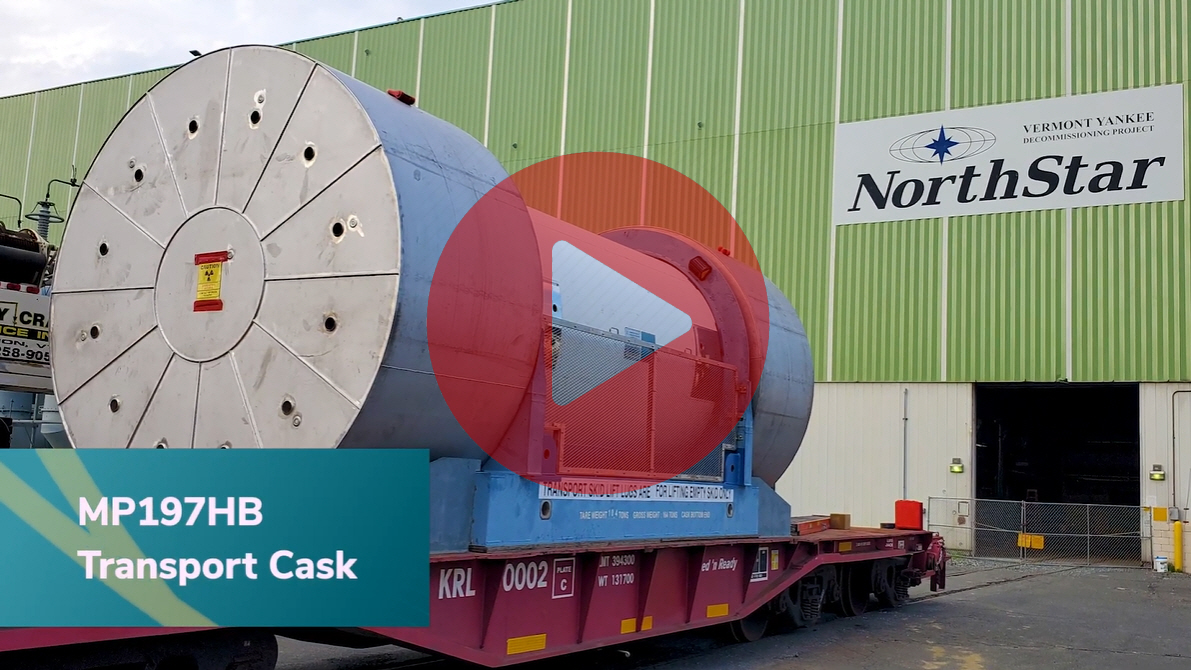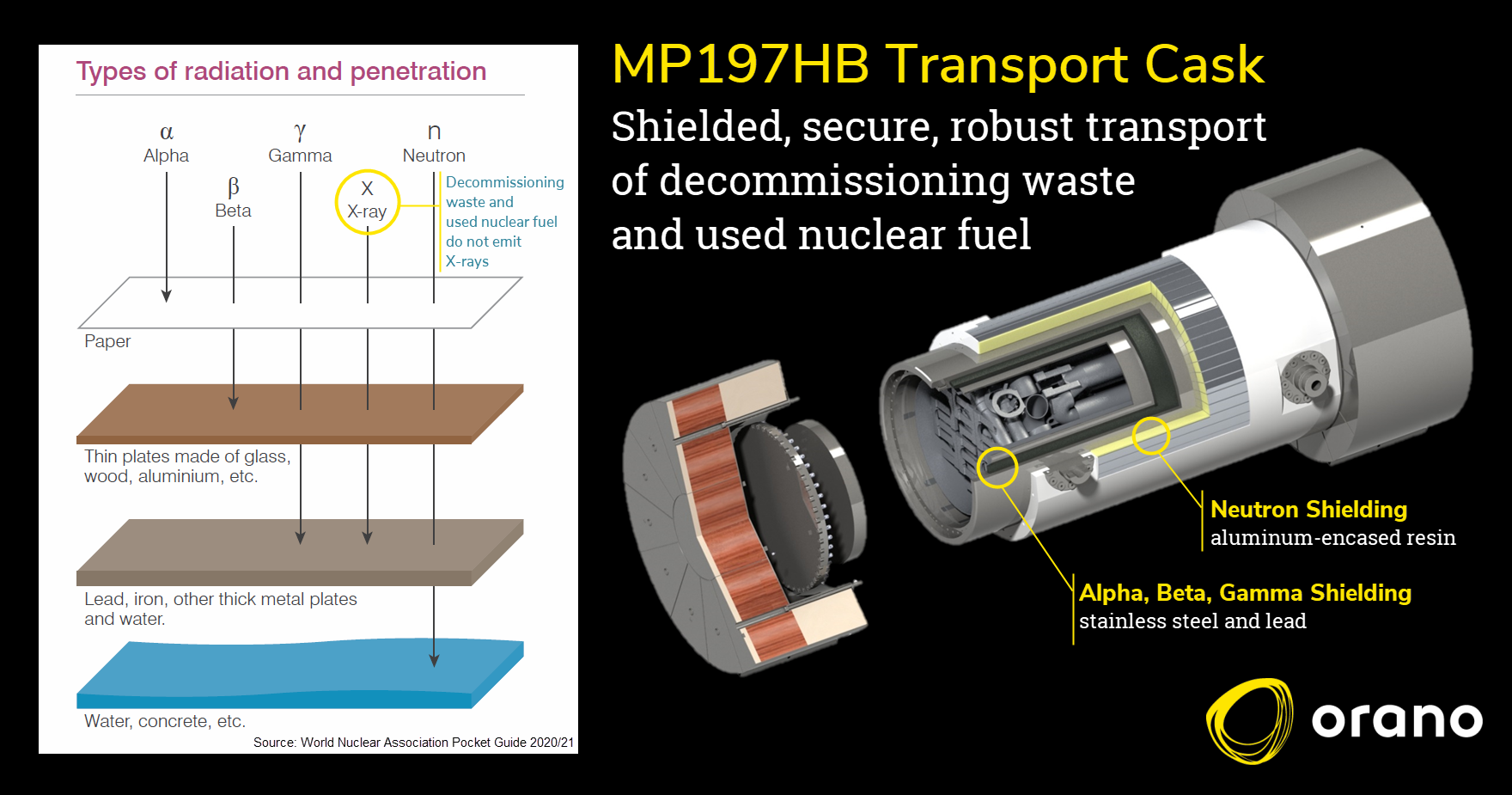Nuclear Transport and Logistics

 We provide safe and proven solutions for transporting uranium, used nuclear fuel, decommissioning waste, and other nuclear materials using a fleet of dedicated packaging and equipment for road, rail and sea transport.
We provide safe and proven solutions for transporting uranium, used nuclear fuel, decommissioning waste, and other nuclear materials using a fleet of dedicated packaging and equipment for road, rail and sea transport.
Watch this video to see U.S. industry preparations for used nuclear fuel transport.
Decommissioning Waste
 The robust shielding and large capacity of Orano's MP197HB transport cask ensure the highest levels of safety and the fewest number of packages and offsite shipments to remove decommissioning waste. The first MP197HB transport cask was manufactured and then delivered by Orano TN in November 2019, and immediately began operations. After crew training sessions with the new cask at Orano’s South Carolina training facility and at the Waste Control Specialists disposal site, Orano TN delivered the cask to Vermont Yankee to begin regular transports.
The robust shielding and large capacity of Orano's MP197HB transport cask ensure the highest levels of safety and the fewest number of packages and offsite shipments to remove decommissioning waste. The first MP197HB transport cask was manufactured and then delivered by Orano TN in November 2019, and immediately began operations. After crew training sessions with the new cask at Orano’s South Carolina training facility and at the Waste Control Specialists disposal site, Orano TN delivered the cask to Vermont Yankee to begin regular transports.Research Reactors / Isotopes
For research reactors and isotopes, Orano TN provides customized nuclear transportation services such as feasibility studies, engineering services and on-site technical assistance. We handle nearly 100 nuclear transports per year for research reactors and laboratories in Australia, France, Japan, Morocco, South Africa, USA, Canada and Indonesia.
- Low Enriched Uranium (LEU)
- High Enriched Uranium (HEU)
- Fresh MTR and TRIGA feed material
- Irradiated MTR and TRIGA fuel elements
- Sources and irradiated samples
Learn more about our Canisters & Casks
Management & Oversight
We are part of a world-class network with safety and quality qualifications that are unparalleled in the industry.
Logistical Schemes- Risk analysis and inspections at key stages of the nuclear transport
- Vigilant selection and oversight of our subcontractors
Crisis Management Program
- Emergency response planning, preparedness and implementation
- Crisis management center that offers support around the clock, 365 days a year
Proven Performance Guarantees
- Safe and reliable nuclear transports
- On-time delivery
- Consistent and comprehensive monitoring of shipments
- Full technical support
Used Nuclear Fuel
Orano's shielded NUHOMS MP197HB transport cask can be used for the offsite transportation of up to 61 or 69 intact or damaged BWR fuel assemblies or up to 24, 32, or 37 intact or damaged PWR fuel assemblies, depending upon the canister type used as a payload. The NUHOMS MP197HB cask can also transport the Radwaste Container (RWC) used to store dry irradiated and/or contaminated non-fuel hardware.
The MP197HB cask is specifically designed for robust, secure transportation:
- Stainless steel shell and cover plates
- Gamma shielding: stainless steel and lead
- Neutron shielding: aluminum-encased resin
- Impact limiters: balsa & redwood encased in stainless steel shells
- Carbon steel closure bolts
- Option of outer fins for high decay heat payload depending upon the regulation
Learn more about our Canisters & Casks

FAQs about Transporting Used Nuclear Fuel
What is used (spent) nuclear fuel?
Used or spent nuclear fuel is a dry, solid ceramic pellet, not a liquid. These pellets are about the size and shape of a large pencil eraser. They are stacked and sealed inside long metal-alloy rods, which are then securely bound into a
rectangular bundle called a fuel assembly. After the radioactive used fuel assemblies are removed from a reactor and cooled underwater for a minimum of two years, they are loaded into large stainless steel canisters, which are vacuum-dried to remove
all liquid and air from the sealed canister, and welded shut. The canister is filled with an inert gas that prevents the fuel from degrading over time. The canisters are stored in large concrete vaults, such as our NUHOMS dry storage system.

Is it safe to transport used fuel?
During more than 50 years of operations, the transportation and dry storage of used nuclear fuel has never harmed people or the environment. Across the globe and in the U.S., the movement of used nuclear fuel has an exemplary track record of safety, and far exceeds the standards for quality and protection required for other hazardous materials using the same
transport infrastructure. Since 1965, more than 2,700 shipments of used fuel have been safely transported nearly 2 million miles across the United States – and there has never been a radiological release caused by a transportation accident.
Globally, more than 200 casks are transported every year, with a total of nearly 10,000 used fuel casks having been delivered.
Why move the fuel to a consolidated interim storage site?
In more than 30 communities across the United States, used nuclear fuel in dry storage is all that remains of a shutdown nuclear reactor site, even though all the reactor buildings may have been decommissioned and removed. Clearing away
this stranded used nuclear fuel will re-open these prime sites for new economic development or community recreational use. Also, every year that the used nuclear fuel remains at numerous sites throughout the U.S. costs taxpayers more money. The federal
government has estimated the cost of this to be approximately $2.2 million per day. Utilities sue the Department of Energy to recover costs from maintaining these remaining used fuel storage sites. The DOE’s taxpayer-funded liabilities are projected
to total $27.1 billion if the DOE does not have a permanent disposal facility by 2021. The proposed ISP consolidated interim storage site would allow used fuel
to be removed from the reactor sites and stored at a significantly lower cost to the taxpayer while a permanent federal disposal site is located and developed.
How is used nuclear fuel prepared and secured for transport?
To transport used fuel assemblies, 24 to 68 assemblies are secured inside a metal-alloy “basket” of a large stainless steel canister. Once loaded and sealed, the canister is placed inside a robust NRC-certified heavy-walled
transport cask engineered with multiple layers of different materials—approximately 4 inches of steel, 3 inches of lead and 6.25 inches of neutron shielding—to protect the fuel assembly from damage, contain the radioactive materials, and
ensure any radiation emissions remain within regulations. Before transporting the fuel from the reactor site, NRC regulations require that the fuel be cooled for many years to minimize the radiation during transportation.
Is there risk of an explosion or external hazard from used nuclear fuel?
The canister containing the dry used nuclear fuel and inert gas cannot explode or even catch fire—it contains no combustible materials. The solid pellets do not burn. In addition, there is no potential for a chemical or physical reaction
that could build pressure inside the canister to cause it to burst. Dry used nuclear fuel in transport and storage is very stable and, therefore, there can be no comparison to Chernobyl or to nuclear weapons, or to the material being disposed at WIPP.
Extensive research, testing and experience has shown that there is no credible way for this solid used fuel material to spread and cause harm in an accident, even one that somehow breaches both the robust transport cask and canister.
What are the expected U.S. transportation routes?
Shippers will work with the railroad operators, route states, the Department of Transportation, and other stakeholders to identify, designate, and prepare the rail routes for shipments. The Nuclear Regulatory Commission must pre-approve
each transportation route in advance. Regulatory requirements include consideration of the most direct route, taking into consideration large cities, any geographical transport concerns, and the capabilities of the infrastructure to handle the used
fuel railcar and cask weight.
Are the casks too heavy for the railroads?
Rail routes selected for transporting used fuel casks are evaluated and approved by regulators for safely handling the weight.
Used fuel is said to be the most radioactive and harmful waste there is. How do we know people are protected along the rail routes and storage site?
Though used nuclear fuel is very radioactive, it has proven to be one of the most securely managed and least harmful waste substances. Along with the significant oversight and regulations governing the transport and storage of used nuclear
fuel in the U.S., we have a personal interest in making sure the men and women working with us and for us are protected, along with our families and the communities along the transportation rail routes and the storage site. Extensive research, testing
and experience has shown that there is no credible way for this solid used fuel material to spread and cause harm in an accident, even one that somehow breaches both the robust transport cask and canister.
What is background radiation?
Radiation is a natural part of our environment and daily lives, and our bodies automatically manage our normal exposure. The normal exposure we all receive every day from “background sources” includes naturally occurring radon
in our air, cosmic rays, radioactive rocks (granite) and soil, and even plants and food that are naturally high in potassium or other radioactive elements (bananas, carrots, avocados, Brazil nuts). The other normal background sources of radiation
exposure are man-made, such as basic medical procedures and consumer products.
Is there a radiation risk to people and communities during the transport of casks containing used nuclear fuel? What about people who get stuck next to a stopped train that’s transporting fuel?
As decades of experience and activities have shown, there is very little risk from the used fuel transport casks to people or communities. The used nuclear fuel is securely contained and shielded to prevent any harm to the transport workers,
the public and our site workers. All aspects of the transport process are monitored for exposure and must meet strict NRC and U.S. Department of Transportation regulations. This ensures that any radiation dose to any member of the public during routine
used nuclear fuel transportation, including stops, is barely discernible compared to the public’s normal daily background radiation from rocks, radon gas, cosmic rays, and other natural sources. Radiation at very small levels is easy to detect
and measure; monitoring during transport ensures all safety and security requirements are fulfilled.
Do harmful X-rays come out of the used fuel in the transport cask?
No, used nuclear fuel does not create or emit X-rays.
Can a cask leak from an accident during transport?
NRC-licensed transport casks have never been breached or leaked from an accident, regardless of the transportation method. Extensive research, testing and experience by the NRC has shown that there is no credible way for this solid used
fuel material to spread and cause harm in an accident, even one that somehow breaches both the transport cask and canister. Orano’s MP197HB transport cask is licensed by the NRC for used nuclear fuel transport.
How are transport casks tested against potential accidents?
To be licensed by the Nuclear Regulatory Commission, the transport cask design has successfully demonstrated it will maintain containment (a leak-tight seal) and shielding (protection from radiation) during a cumulative sequence of accident
scenarios, including drops or high-velocity impacts, punctures, intense fires, and immersion underwater. The metal canister holding the used fuel inside the cask provides an additional level of protection.

What about accidents with fires that burn hotter and longer than expected, or longer submersions, and impacts from different angles?
The fire accident scenario addressed by the regulations is a very conservative, bounding fire that includes three key attributes: temperature, duration, and that the package is fully engulfed in the flames for the entire duration. While
a hypothetical fire may burn hotter or for a longer duration than the fire accident addressed in the regulations, what makes the regulatory fire bounding is that the package is fully engulfed for the duration of the fire. This is not likely to occur
during an actual accident. Additionally, for any real-life experiences or accidents, the NRC reviews the cask design requirements to ensure they are conservative and cover those experiences.
What if an accident causes a used fuel transport cask to come off the rails?
The used fuel storage transport casks are very strong and resilient, and designed to make it highly unlikely they could sustain damage from an accident significant enough to be a concern. In two incidents in Europe where a used fuel transport
cask was knocked off its mode of transport, the casks were carefully inspected and verified that they maintained their sealed integrity and continued to keep the fuel in a safe condition, and then lifted onto new transport for continued shipment.
The NRC regulations for transport cask design address this concern.
What about used nuclear fuel that is damaged or high burn-up fuel?
The Transportation casks are designed to safely transport high burn-up fuel and are reviewed and approved by the NRC under 10 CFR Part 71 regulations. Damaged fuel is required to be confined within a basket compartment inside the canister
with secondary containers or end caps. The accident scenarios in safety evaluations include the assumption that the fuel structures in the cask become damaged and broken, but analyses show this damage to the fuel does not prevent the rest of the system
from performing any safety functions and continues to protect the public. In France alone, more than 21,000 high burn-up used fuel assemblies have been safely transported without incident to the La Hague reprocessing facility.
